

Education Week. Why schools shouldn't approach technology like businesses once did. Computers began reaching the business world during the 1980s.
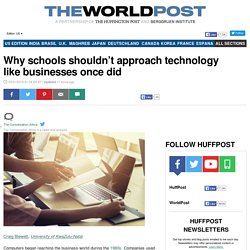
Companies used them to automate many routine manual tasks. This led to what economist Robert Solow dubbed the Productivity Paradox. In 1987, he famously quipped: “You can see the computer age everywhere but in the productivity statistics.” Why I hate TED talks. Everyone seems to trust TED talks, but they're really not a good way to get ideas about education.

Here's why. Redesigning Learning Spaces: Sharing #GeniusHour Projects. Anytime I think that my students have produced something interesting, I want to share it.
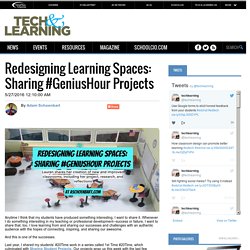
Whenever I do something interesting in my teaching or professional development--success or failure, I want to share that, too. I love learning from and sharing our successes and challenges with an authentic audience with the hopes of connecting, inspiring, and sharing our awesome. And this is one of the successes. Last year, I shared my students’ #20Time work in a series called 1st Time #20Time, which culminated with Sharing Student Projects.
Our projects wrap up this week with the last few presentations, and I plan to share those, along with reflections from me and my students soon. Schools as businesses: when education doesn't always come first. The “Official” Theory of Learning — Modern Learning. Here’s your Friday moment of EduZen to think about over the weekend… Frank Smith’s The Book of Learning and Forgetting is one of those reads that had me nodding my head the entire way through it.
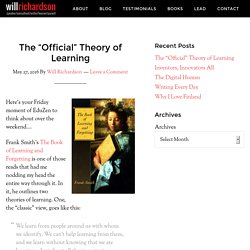
In it, he outlines two theories of learning. One, the “classic” view, goes like this: AltSchool students choose what they want to do before the day officially starts. - A morning at the AltSchool, an education startup that Silicon Valley is crazy about. Digital Promise Puts Education Research All In One Place. As technology becomes an accepted tool in many classrooms, teachers and administrators are looking for the best ed-tech tools to advance their goals around student learning.

Unfortunately, there are so many tools on the market claiming to be the best option, it can be hard to sort through the noise and make an informed decision. Digital Promise, the congressionally authorized nonprofit charged with “accelerating innovation in education to improve opportunities to learn,” has developed a tool to help educators and ed-tech developers sort through relevant research. “There is more and more pressure for people to use research in their work,” said Sarita Bhargava, chief communications officer for Digital Promise.
“We hope this tool will provide the first step.” The Digital Promise research team used Web of Science, a tool that allows users to cite by citation, to put together a network of peer-reviewed research articles related to education. Reflection: A Tool for Assessment, Empowerment, and Self-Awareness. Reflecting takes many forms in the classroom, and it is an integral and indispensable part of education.
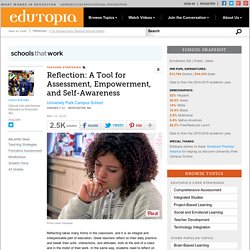
Great teachers reflect on their daily practice and tweak their units, interactions, and attitudes, both at the end of a class and in the midst of their work. In the same way, students need to reflect on their actions and their work in order to build their classroom community and increase their own knowledge and skills. If you want to integrate reflection into your teaching practice, here are seven tips that you can start implementing in your classroom now. Daniel Willingham: The false promise of tech in schools. It’s time to admit we don’t know what we’re doing when it comes to educational technology.
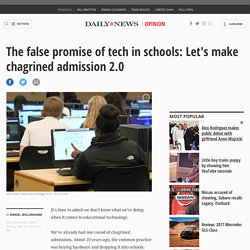
We’ve already had one round of chagrined admissions. About 10 years ago, the common practice was buying hardware and dropping it into schools: Every student got a laptop, perhaps, or every classroom got a computer-driven whiteboard. Policymakers finally realized that such purchases don’t boost student achievement or create a new generation of programmers. Better planning is now more common, but it’s time for chagrined admission 2.0. The problem is that tech purchasing decisions are usually not much better informed than your decision about whether or not to buy a smartwatch. Consider Amazon’s recent $30 million contract to sell e-books to New York City schools over a three-year period. Reading on a screen would seem to be little different than reading on paper. Or consider the common notion that the Internet has changed what should be taught in school. Anti-Bias Education: The Power of Social-Emotional Learning. Today's guest blog is written by Jinnie Spiegler, Director of Curriculum at the Anti-Defamation League.

How is social and emotional learning (SEL)--which is now an established and critical part of the school experience--connected with anti-bias education? If we want to help young people understand bias and work on social justice, what does SEL bring to the table? According to Collaborative for Academic, Social and Emotional Learning (CASEL), social and emotional learning is "the process through which children and adults acquire and effectively apply the knowledge, attitudes, and skills necessary to understand and manage emotions, set and achieve positive goals, feel and show empathy for others, establish and maintain positive relationships, and make responsible decisions. " Five Myths About Classroom Technology (And What To Do, Instead) Classroom technology is everywhere.
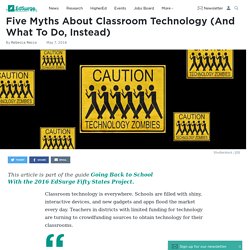
Schools are filled with shiny, interactive devices, and new gadgets and apps flood the market every day. Yet Another Study Finds That Having An “Authentic Audience” Impacts Student Learning. I’ve previously posted research finding that students having an “authentic audience” – someone other than their teacher or classmates – can have a positive impact on learning (see Another Study Points To The Importance Of Students Writing For An Authentic Audience and Do You Know Of Research Showing That Writing For An “Authentic Audience” Helps Students Feel Motivated?).
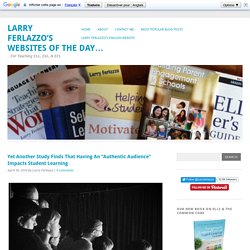
I’ve also shared places where students can do just that online at The Best Places Where Students Can Write For An “Authentic Audience” and The Best Places Where Students Can Create Online Learning/Teaching Objects For An “Authentic Audience.” I’ve also shared how my students find authentic audiences in our Geography class (see Links To The Joint Projects My ELL Geography Class Did With Classes Around The World – Want To Join Us This Year?). A new study has come out where a science teacher used Twitter to connect to that kind of audience. Transforming teaching with Twitter is a Science Daily summary of the research. Related. Why Lots of Love (or Motivation) Isn't Enough. I get a kick out of spotting invisible threads that connect disparate theories and lines of research. Sometimes I’ll even notice a pattern (after the fact) in my own essays about different topics — which can be gratifying until I realize that the common denominator is embarrassingly simple. One observation I’ve offered in various contexts is that “how much” tends to matter less than “what kind.”
Researchers Hunt for ‘Secret Sauce’ of Digital Learning Success. What makes some digital learning initiatives successful and others not? That’s the focus of a 2014 study released Wednesday by the America’s Promise Alliance’s Center for Promise. The study is titled "Wired to Learn: K-12 Students in the Digital Classroom," and it examines how five school districts implemented digital learning strategies to help students succeed in the classroom and how those initiatives performed. Schools have seen mixed results from digital strategies, which could be a result of their varying implementation plans, according to the report. “Scholars have noted that benefits tend to be more substantial when blended learning (versus a purely online experience) is used and when the time devoted to instruction with technology supplements, and not replaces, the time spent without it,” the report states. Jonathan Zaff, executive director for the Center for Promise, said in a Wednesday news conference on the report that education was on the precipice of a digital revolution.
Education-2025 - The Classroom of the Future. The Physical Space The days of classrooms where a teacher desk sits at the front of the classroom and students’ desks are neatly aligned in rows are over. Learning technologies, and changing pedagogical methods, are not only changing the way we teach but also the physical environments we teach in. Taking Notes With A Pen And Paper Could Help Retain Information; Study. NEW YORK (CBSNewYork) — If you want to be smarter you might want to swap out your smart phone for a pen and paper. A new study out of Princeton found that there’s no replacement for old school note taking. How Social Media is Reshaping Today's Education System. 16 skills students need to learn today to thrive tomorrow. The gap between the skills people learn and the skills people need is becoming more obvious, as traditional learning falls short of equipping students with the knowledge they need to thrive, according to the World Economic Forum report New Vision for Education: Fostering Social and Emotional Learning Through Technology.
Making Technology Click in the Classroom: Teachers Share What Makes Digital Tools "Worth The Time" Reviewed: 3 Office Layouts to Dramatically Improve Your Productivity. Welcome the the Copyright Jungle. The movement toward going open is spreading like wildfire among the education community, but the challenge of navigating through the jungle of copyright law can quickly dampen that enthusiasm.
Nocookies. 8 Printable Classroom Coupons Students Will Love. Why Edtech is Flunking Out. “Unfiltered News” Visualizes Most Popular News Topics In Different Countries. Unfiltered News, which only works in Chrome, provides visualizations of the most popular news stories in each country. 6 Rising Technology Trends In Public School Classrooms - 3 Keys to Designing Learner-Centered Spaces.
For Internet Access, Hop on the Bus—and Discover What Really Prevents Teachers from Using Digital Tools. To see the impact of the digital divide in rural Kentucky, look no further than the parking lot of Eminence High School when school isn’t in session. “We see kids in their cars in the parking lot at night and on weekends,” says Buddy Berry, superintendent of Eminence Independent Schools.
They’re there, he says, because they can access the Internet using the school’s wireless network—something many don’t have at home. We’re teaching our kids wrong: Steve Jobs and Bill Gates do not have the answers. Are Learning Styles Real - and Useful?